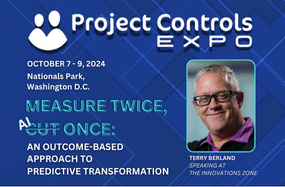
Measure Twice, AI Once: Why AEC Companies Should Approach AI Initiatives “Backwards”

In the Architecture, Engineering, and Construction (AEC) industry, the adoption of Artificial Intelligence (AI) is quickly becoming a strategic necessity. From optimizing design processes to enhancing project management and predictive maintenance, AI has the potential to revolutionize the way AEC companies operate. However, the path to successful AI implementation is fraught with challenges, particularly when it comes to defining the approach. While it may seem logical to start with the data—the lifeblood of any AI system—a more effective strategy is to work the problem “backwards.” This non-intuitive approach begins with defining the business goal and then methodically working back through the steps needed to achieve that goal, ensuring that the AI initiative is perfectly aligned with the company’s strategic objectives.
The Traditional Approach: Why It Falls Short
Many AEC companies instinctively start their AI initiatives by focusing on data—identifying sources, inputs, and analytics to apply. While data is undeniably crucial, starting with data can lead to a range of issues:
- Misalignment with Business Goals: When the focus is on data from the outset, there is a risk that the AI solution developed will be misaligned with the company’s strategic objectives. The result may be a technically sophisticated solution that fails to address the real business challenges.
- Overcomplication: Starting with data can lead to the development of overly complex systems that are difficult to manage and integrate into existing workflows. This complexity can result in increased costs and project delays.
- Data Overload: Focusing on data first can also lead to the collection of vast amounts of irrelevant or unnecessary information, creating noise that makes it harder to extract meaningful insights.
The Backward Approach: Starting with the End in Mind
A more effective strategy for AEC companies is to approach AI initiatives by working backwards. This methodical process ensures that every step is directly tied to the achievement of a specific business goal, leading to more efficient, effective, and impactful AI solutions.
1. Start with the Business Goal: The first step is to clearly define the specific business goal the AI initiative is intended to achieve. Whether it’s reducing project costs, improving safety, or enhancing design accuracy, this goal should be well-defined and measurable. By focusing on the end result from the beginning, AEC companies can ensure that the AI solution developed is directly aligned with their strategic objectives.
2. Define the Key Questions: Once the business goal is established, the next step is to determine the key questions that need to be answered to achieve that goal. For example, if the goal is to reduce project costs, relevant questions might include: “Which stages of the project are most prone to cost overruns?” or “What factors most influence cost variability?” Defining these questions helps to focus the AI initiative on the specific areas that will drive the most value.
3. Determine the Necessary Analytics: With the key questions in mind, the next step is to define the types of analytics needed to answer those questions. For instance, predictive analytics might be required to forecast cost overruns, while pattern recognition could be used to identify factors influencing cost variability. By clearly defining the necessary analytics, companies can ensure that their AI solution is equipped to deliver the insights needed to achieve the business goal.
4. Identify the Required Inputs: After determining the analytics, the next step is to identify the inputs needed to feed those analytics. These inputs might include specific metrics, KPIs, or variables that are critical to answering the key questions. For example, inputs for cost-related analytics might include historical project data, material costs, or labor rates.
5. Select the Data Sources: Finally, with the inputs defined, the last step is to identify the specific data sources required to provide those inputs. This might involve accessing internal databases, external data providers, or IoT sensors. By focusing on data sources last, companies can ensure that they are only collecting the data that is truly necessary to achieve their business goal.
In the AEC industry, where precision and alignment are key to success, the traditional approach of starting with data can lead to misalignment and inefficiencies. Instead, by adopting a backward approach—starting with the business goal and working back through the necessary steps—AEC companies can ensure that their AI initiatives are perfectly aligned with their strategic objectives. This “measure twice, AI once” strategy not only minimizes the risk of failure but also maximizes the potential for AI to drive meaningful, measurable business outcomes.








